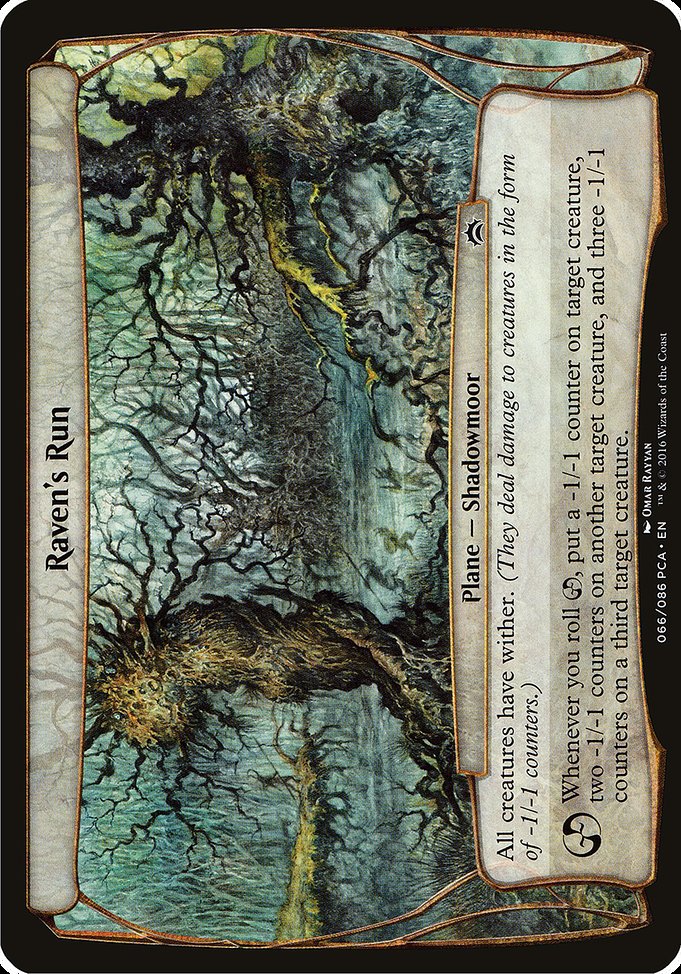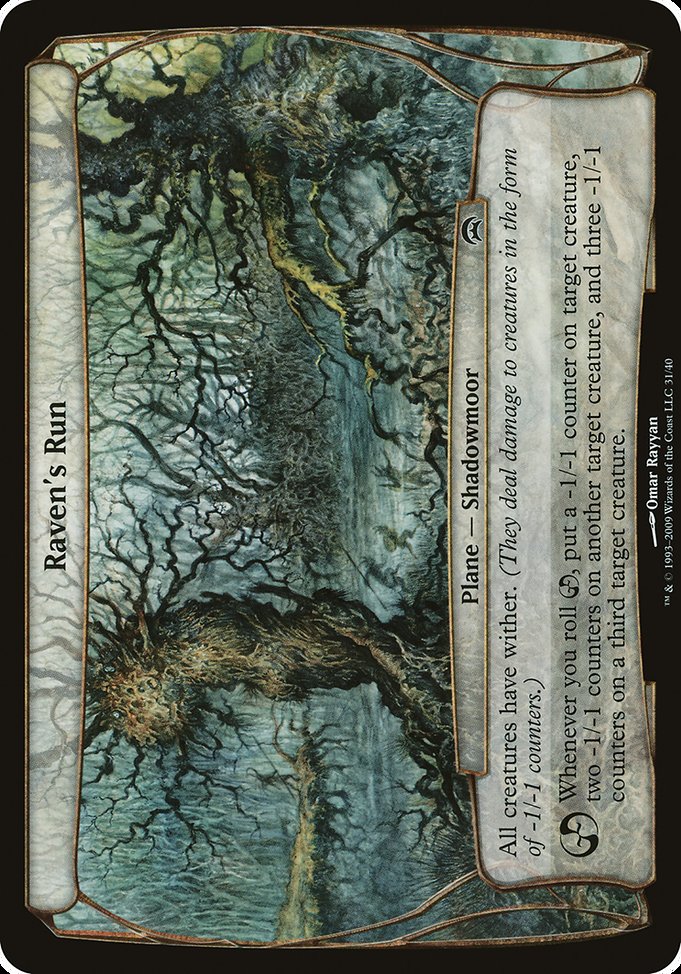Garenne du Corbeau
Plan : Sombrelande
Toutes les créatures ont la flétrissure. (Elles infligent des blessures aux créatures sous la forme de marqueurs -1/-1.)
À chaque fois que vous obtenez chaos, mettez un marqueur -1/-1 sur une créature ciblée, deux marqueurs -1/-1 sur une autre créature ciblée, et trois marqueurs -1/-1 sur une troisième créature ciblée.
À chaque fois que vous obtenez chaos, mettez un marqueur -1/-1 sur une créature ciblée, deux marqueurs -1/-1 sur une autre créature ciblée, et trois marqueurs -1/-1 sur une troisième créature ciblée.
standard
future
historic
gladiator
pioneer
explorer
modern
legacy
pauper
vintage
penny
commander
brawl
historicbrawl
alchemy
paupercommander
duel
oldschool
premodern
Rulings
If an ability of a plane refers to “you,” it’s referring to whoever the plane’s controller is at the time, not to the player that started the game with that plane card in their deck. Many abilities of plane cards affect all players, while many others affect only the planar controller, so read each ability carefully.
Wither applies to any damage, not just combat damage.
The controller of a face-up plane card is the player designated as the “planar controller.” Normally, the planar controller is whoever the active player is. However, if the current planar controller would leave the game, instead the next player in turn order that wouldn’t leave the game becomes the planar controller, then the old planar controller leaves the game. The new planar controller retains that designation until they leave the game or a different player becomes the active player, whichever comes first.
You must target three different creatures when the chaos ability triggers, even if that means you have to target creatures you control. If you can’t target three creatures (because there are just two creatures on the battlefield, perhaps), the ability is removed from the stack and does nothing.
A plane card is treated as if its text box included “When you roll {PW}, put this card on the bottom of its owner’s planar deck face down, then move the top card of your planar deck off that planar deck and turn it face up.” This is called the “planeswalking ability.”
Since damage from a creature with wither is real damage, it follows all the other rules for damage. It can be prevented or redirected. When it’s dealt, it will cause “Whenever [this creature] deals damage” and “Whenever [this creature] is dealt damage” abilities to trigger.
The -1/-1 counters that result from wither remain on the damaged creature indefinitely. They won’t be removed if the creature regenerates or the turn ends.
If the source of the damage is still on the battlefield at the time that damage is dealt, its characteristics are checked to see if it has wither. If the source has left the battlefield by then, its last existence on the battlefield is checked to see if it had wither.
Damage from creatures with wither affects players and planeswalkers normally.
Multiple instances of wither are redundant.
A face-up plane card that’s turned face down becomes a new object with no relation to its previous existence. In particular, it loses all counters it may have had.
Wither applies to any damage, not just combat damage.
The controller of a face-up plane card is the player designated as the “planar controller.” Normally, the planar controller is whoever the active player is. However, if the current planar controller would leave the game, instead the next player in turn order that wouldn’t leave the game becomes the planar controller, then the old planar controller leaves the game. The new planar controller retains that designation until they leave the game or a different player becomes the active player, whichever comes first.
You must target three different creatures when the chaos ability triggers, even if that means you have to target creatures you control. If you can’t target three creatures (because there are just two creatures on the battlefield, perhaps), the ability is removed from the stack and does nothing.
A plane card is treated as if its text box included “When you roll {PW}, put this card on the bottom of its owner’s planar deck face down, then move the top card of your planar deck off that planar deck and turn it face up.” This is called the “planeswalking ability.”
Since damage from a creature with wither is real damage, it follows all the other rules for damage. It can be prevented or redirected. When it’s dealt, it will cause “Whenever [this creature] deals damage” and “Whenever [this creature] is dealt damage” abilities to trigger.
The -1/-1 counters that result from wither remain on the damaged creature indefinitely. They won’t be removed if the creature regenerates or the turn ends.
If the source of the damage is still on the battlefield at the time that damage is dealt, its characteristics are checked to see if it has wither. If the source has left the battlefield by then, its last existence on the battlefield is checked to see if it had wither.
Damage from creatures with wither affects players and planeswalkers normally.
Multiple instances of wither are redundant.
A face-up plane card that’s turned face down becomes a new object with no relation to its previous existence. In particular, it loses all counters it may have had.
Rulings
If an ability of a plane refers to “you,” it’s referring to whoever the plane’s controller is at the time, not to the player that started the game with that plane card in their deck. Many abilities of plane cards affect all players, while many others affect only the planar controller, so read each ability carefully.
Wither applies to any damage, not just combat damage.
The controller of a face-up plane card is the player designated as the “planar controller.” Normally, the planar controller is whoever the active player is. However, if the current planar controller would leave the game, instead the next player in turn order that wouldn’t leave the game becomes the planar controller, then the old planar controller leaves the game. The new planar controller retains that designation until they leave the game or a different player becomes the active player, whichever comes first.
You must target three different creatures when the chaos ability triggers, even if that means you have to target creatures you control. If you can’t target three creatures (because there are just two creatures on the battlefield, perhaps), the ability is removed from the stack and does nothing.
A plane card is treated as if its text box included “When you roll {PW}, put this card on the bottom of its owner’s planar deck face down, then move the top card of your planar deck off that planar deck and turn it face up.” This is called the “planeswalking ability.”
Since damage from a creature with wither is real damage, it follows all the other rules for damage. It can be prevented or redirected. When it’s dealt, it will cause “Whenever [this creature] deals damage” and “Whenever [this creature] is dealt damage” abilities to trigger.
The -1/-1 counters that result from wither remain on the damaged creature indefinitely. They won’t be removed if the creature regenerates or the turn ends.
If the source of the damage is still on the battlefield at the time that damage is dealt, its characteristics are checked to see if it has wither. If the source has left the battlefield by then, its last existence on the battlefield is checked to see if it had wither.
Damage from creatures with wither affects players and planeswalkers normally.
Multiple instances of wither are redundant.
A face-up plane card that’s turned face down becomes a new object with no relation to its previous existence. In particular, it loses all counters it may have had.
Wither applies to any damage, not just combat damage.
The controller of a face-up plane card is the player designated as the “planar controller.” Normally, the planar controller is whoever the active player is. However, if the current planar controller would leave the game, instead the next player in turn order that wouldn’t leave the game becomes the planar controller, then the old planar controller leaves the game. The new planar controller retains that designation until they leave the game or a different player becomes the active player, whichever comes first.
You must target three different creatures when the chaos ability triggers, even if that means you have to target creatures you control. If you can’t target three creatures (because there are just two creatures on the battlefield, perhaps), the ability is removed from the stack and does nothing.
A plane card is treated as if its text box included “When you roll {PW}, put this card on the bottom of its owner’s planar deck face down, then move the top card of your planar deck off that planar deck and turn it face up.” This is called the “planeswalking ability.”
Since damage from a creature with wither is real damage, it follows all the other rules for damage. It can be prevented or redirected. When it’s dealt, it will cause “Whenever [this creature] deals damage” and “Whenever [this creature] is dealt damage” abilities to trigger.
The -1/-1 counters that result from wither remain on the damaged creature indefinitely. They won’t be removed if the creature regenerates or the turn ends.
If the source of the damage is still on the battlefield at the time that damage is dealt, its characteristics are checked to see if it has wither. If the source has left the battlefield by then, its last existence on the battlefield is checked to see if it had wither.
Damage from creatures with wither affects players and planeswalkers normally.
Multiple instances of wither are redundant.
A face-up plane card that’s turned face down becomes a new object with no relation to its previous existence. In particular, it loses all counters it may have had.
Votre collection ? vos decks ?
Envie de gérer votre collection et/ou créer des decks ?



 0
0
 1.38€
1.38€